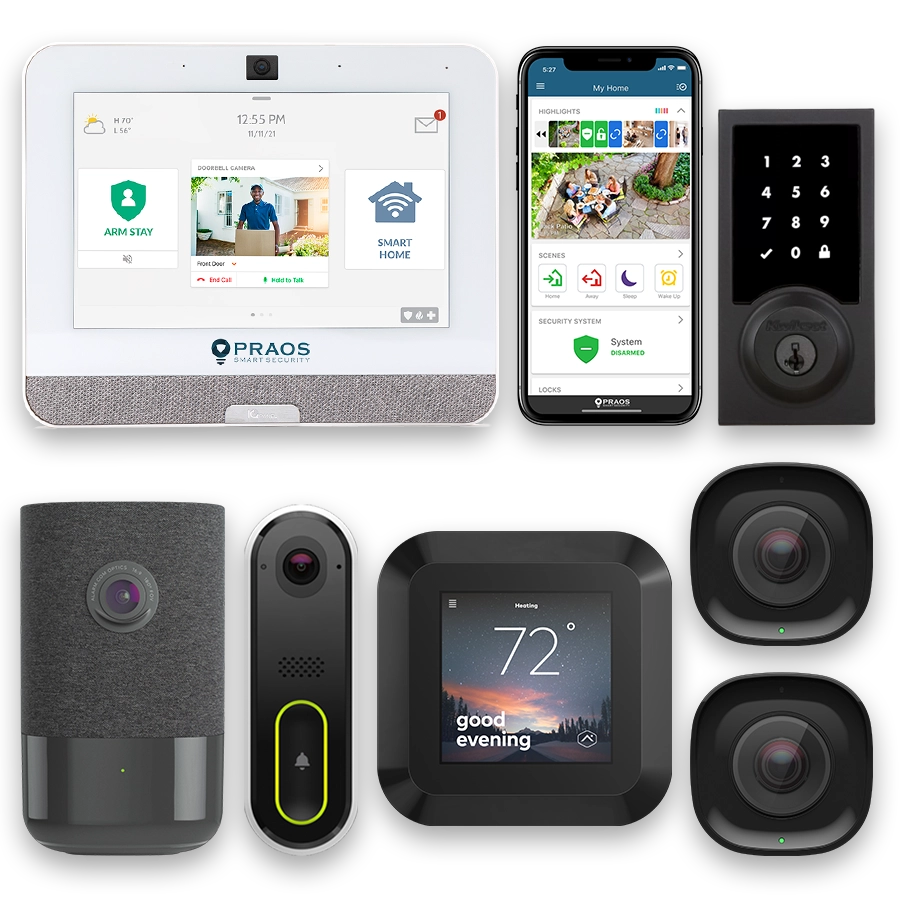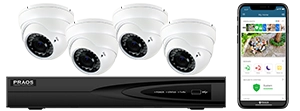Understanding the Basics of Smart Home Security Systems
Understanding the Basics of Smart Home Security Systems
Smart home security systems are designed to provide enhanced protection through the use of interconnected devices and technologies. Unlike traditional security systems, these systems allow homeowners to monitor and manage their security through smartphones, tablets, or computers, often in real-time.
The core function of a smart home security system is to detect unauthorized entry into a home. This is achieved through a combination of sensors, cameras, and alarms that can communicate with each other and with the homeowner. The integration of these devices into a central hub or control panel enables streamlined management and efficient response to potential threats.
Key features of modern smart home security systems include:
- Remote Monitoring: Homeowners can monitor their property from anywhere in the world using a compatible app or web interface.
- Instant Alerts: Notifications are sent to the homeowner’s devices if an alarm is triggered, allowing for immediate action.
- Automation: Integration with other smart home devices, such as lighting and smart locks, enables automated responses to security events.
- Video Surveillance: Cameras can provide live feeds or record footage for later review. Some systems offer features like motion detection and night vision.
- Environmental Monitoring: In addition to security, many systems offer sensors for smoke, fire, carbon monoxide, and water leaks.
Smart home security systems often employ a variety of device types, which can include:
- Security Cameras: Both indoor and outdoor cameras monitor activity and can provide visual evidence of security events.
- Motion Detectors: These sensors detect movement in designated areas and can trigger alarms or cameras when movement is detected.
- Door and Window Sensors: These devices detect the opening and closing of doors and windows, alerting homeowners to potential intrusions.
- Smart Alarms: Integrate sirens or lights that can be triggered remotely or automatically in response to specific events.
- Control Panels or Hubs: Centralized devices that manage communication between all connected security components.
Understanding these basics is critical to making informed decisions when selecting and installing a smart home security system on a budget. By knowing what features and devices are most important, homeowners can prioritize spending and ensure they get the best value for their investment.
Essential Components and Their Costs
For those looking to set up a smart home security system on a budget, it’s crucial to understand the essential components and their costs.
Control Panel or Hub
The control panel or hub acts as the central unit for your smart home security system. It is responsible for communicating with all connected devices. Generally, these can range from $50 to $200 depending on the features and brand.
Door and Window Sensors
Door and window sensors alert you to any unauthorized entry. You can find basic models for around $10 to $30 each. More advanced versions with additional features may cost up to $50 each.
Motion Detectors
Motion detectors are essential for monitoring movement within your home. Basic motion sensors can be found for approximately $20 to $50. More sophisticated models that include features like pet immunity or dual technology (PIR and microwave) generally cost between $50 and $100.
Security Cameras
Security cameras serve as the eyes of your smart home security system. Prices vary widely based on resolution, features, and brand. Basic indoor cameras start at around $30 to $60. Outdoor cameras with weatherproofing and additional features like night vision or two-way audio can range from $60 to $200.
Smart Locks
Smart locks allow you to control and monitor your home’s entry points remotely. Budget-friendly models start at around $100, while more advanced versions with features such as Wi-Fi connectivity or fingerprint sensors can go up to $250.
Additional Components
Depending on your needs, you might consider adding other devices:
- Smoke Detectors: Smart smoke detectors usually range from $30 to $100.
- Siren/Alarms: Standalone sirens can be added for around $20 to $50.
- Water Leak Sensors: Costing approximately $15 to $60, these can detect leaks and prevent water damage.
- Video Doorbells: Typically priced between $100 and $250.
Overall, the cost of a basic smart home security system can be kept relatively low by selecting essential components and opting for budget-friendly brands. This approach ensures you have a comprehensive system in place without breaking the bank.
Budget-Friendly Smart Home Security Devices and Brands
When setting up a smart home security system on a budget, it is crucial to select devices that are both cost-effective and reliable. Several brands offer budget-friendly options without compromising on quality and security features.
Wyze is a well-known brand that provides affordable security devices. Their Wi-Fi cameras, such as the Wyze Cam v3, offer features like 1080p video quality, night vision, and motion detection for a low price. Additionally, Wyze also offers other security components like smart locks and sensors, making it easier to create a comprehensive security system.
Ring is another brand that offers economical security devices. The Ring Video Doorbell is a popular choice, providing features such as two-way communication, high-definition video, and motion alerts. Ring also offers subscription plans for cloud storage that are reasonably priced, making it a viable solution for home security on a budget.
TP-Link offers the Kasa Smart line, which includes cameras, plugs, and other smart devices. The Kasa Cam provides high-definition video, motion detection, and night vision, and integrates well with other Kasa smart devices. The affordability of TP-Link products makes them an attractive option for budget-conscious consumers.
SimpliSafe is another reliable brand for budget-friendly home security solutions. They offer customizable security systems that include sensors, cameras, and optional professional monitoring plans. SimpliSafe’s equipment is relatively affordable and does not require long-term contracts, allowing flexibility for users on a budget.
It’s also worth considering the Google Nest lineup for affordable yet high-quality security devices. The Nest Mini and Nest Hub can integrate with other security components like the Nest Cam. While Google Nest products may be slightly more expensive than other budget-friendly options, their reliability and seamless integration with other Google services can offer good value.
By choosing from these budget-friendly brands and devices, it is possible to set up an effective smart home security system without exceeding your budget. Each brand offers different strengths, allowing for a customized solution that meets individual security needs and financial constraints.
Step-by-Step Guide to Installation and Setup
Setting up a smart home security system can be a straightforward process if you follow the right steps. Here is a detailed, step-by-step guide to help you with the installation and setup of your smart home security system on a budget.
1. Plan Your System Layout
Before you start the installation, it’s crucial to determine where each component will be positioned. Identify vulnerable areas in your home such as entry points, windows, and garages. Draw a rough sketch to visualize the placement of cameras, sensors, and other devices.
2. Gather Necessary Tools
Ensure you have all the necessary tools for installation. This typically includes:
- Drill and drill bits
- Screwdrivers
- Level
- Measuring tape
- Stepladder
- Cable ties
- Mounting brackets (usually provided with devices)
3. Install Security Cameras
Start with the security cameras as they often require the most effort to install.
- Mounting: Use the included brackets to mount the cameras in the predetermined locations. Ensure they are at an appropriate height and angle for optimal coverage.
- Power Supply: If using wired cameras, connect them to power outlets and run the cables neatly using cable ties. For wireless cameras, ensure they have a strong Wi-Fi signal.
- Connectivity: Follow the manufacturer’s instructions to connect the cameras to your home network.
4. Install Sensors
Sensors, such as door/window sensors and motion detectors, are generally easy to install. Most of these devices are wireless and come with adhesive backing.
- Placement: Attach door/window sensors directly onto the frame of the door or window. Motion detectors should be placed in corners and high traffic areas.
- Calibration: Test the sensors after installation to ensure they are correctly detecting motion or open/close actions.
5. Setup the Hub or Control Panel
The hub or control panel is the brain of your smart home security system. Place the hub in a central location within your home for optimal communication with all devices.
- Connectivity: Connect the hub to your home router via Ethernet or Wi-Fi as per the device’s requirements.
- Configuration: Follow the system’s instructions to add and configure each device through the control panel interface or the associated app.
6. Test the System
Once all devices are installed and connected to the hub, it’s essential to test the entire system. Conduct walk-through tests to ensure each camera, sensor, and alarm is functioning correctly. Adjust the positioning of any devices that are not performing as expected.
7. Configure Alerts and Notifications
Set up alerts and notifications based on your preferences. Most systems allow you to receive notifications via smartphone apps, email, or SMS when an alarm is triggered.
8. Set Access Controls
Configure users and access levels for your system. This usually involves setting up user accounts and permissions through the control panel or app. Ensure that only trusted individuals have access to the system controls.
By carefully following these steps, you can ensure a smooth installation and setup process for your budget-friendly smart home security system.
Maximizing Security on a Budget: Tips and Tricks
Maximizing the security of your smart home on a budget requires strategic planning, optimizing device placement, leveraging technology, and adhering to best practices in home security. Here are several tips and tricks to help you get the most out of your smart home security system without breaking the bank.
Tip 1: Optimize Device Placement
Ensure that security devices such as cameras, motion sensors, and smart doorbells are placed in strategic locations. These include entry points like doors and windows, as well as high traffic areas in and around your home. Proper placement can maximize the effectiveness of your security devices.
Tip 2: Utilize Multi-functional Devices
Many smart home security devices offer multiple functions that can save you money. For example, a smart doorbell can also function as a security camera and intercom. Using devices with multiple capabilities can reduce the need to purchase additional equipment.
Tip 3: Take Advantage of Free Features
Some smart home devices and apps offer free features that can enhance home security. For instance, many security cameras provide free cloud storage for a limited period or basic motion detection alerts with no additional cost. Make sure to leverage these features before considering paid upgrades.
Tip 4: Automate Schedules and Alerts
Automation can significantly enhance the security of your home by scheduling devices to arm or disarm at specific times. Setting up automatic lighting schedules can deter potential intruders by making your home appear occupied, even when you’re not there. Also, configure alerts so you are immediately notified of any unusual activity.
Cost-Effective Security Measures
Incorporate some affordable and non-tech security measures that can complement your smart home system. These include reinforcing door locks, using window bars, and installing deadbolts.
- Reinforce entry points
- Install additional lights
- Use window and door alarms
Table: Free vs. Paid Features Comparison for Common Devices
| Device | Free Features | Paid Features |
|---|---|---|
| Security Cameras | Basic motion detection, Limited cloud storage | Advanced motion detection, Extended cloud storage |
| Smart Doorbells | Live video streaming, Basic notifications | Video recording, Enhanced notifications |
| Motion Sensors | Basic alerts, Integrations with other devices | Advanced alert customization, Activity zones |
Tip 5: Regular Updates and Maintenance
Keep your smart home security system updated with the latest firmware and software updates. Regular maintenance ensures that your system runs smoothly and securely, reducing the risk of vulnerabilities and improving the overall efficiency of your devices.
Maintaining and Upgrading Your Smart Home Security System
Maintaining a smart home security system requires regular attention to ensure it continues to function effectively. Routine maintenance helps prevent potential security breaches, and scheduled upgrades keep the system current with new technology and capabilities.
Regular Maintenance Tasks
- Firmware Updates: Manufacturers often release firmware updates to fix bugs, enhance performance, and improve security. Regularly check for updates for all smart devices and install them as soon as they become available.
- Battery Checks: Many smart devices, like sensors and cameras, run on batteries. Set a schedule to check and replace batteries to avoid downtime. Rechargeable devices should be periodically recharged.
- Wi-Fi Connectivity: Ensure all devices are consistently connected to your Wi-Fi network. A strong and stable connection is essential for optimal performance. Consider rebooting your router monthly and relocating devices to improve signal strength.
- Physical Inspections: Examine all equipment for signs of wear and tear. Clean lenses on cameras and remove any obstructions affecting sensors to ensure they operate correctly.
Upgrading Your System
As technology advances, upgrading components of your smart home security system can increase its effectiveness and longevity. Here are some cost-effective ways to upgrade:
- Adding New Devices: Incorporating additional sensors or cameras can cover more areas of your home. Newer models often come with better features and enhanced capabilities.
- Improving Network Infrastructure: A strong and robust Wi-Fi network is crucial for smart home devices. Consider upgrading your router or adding mesh network systems to eliminate dead spots and boost connectivity.
- Integrating with Other Smart Home Systems: Expanding your smart home security setup to work with other smart devices, such as lighting and thermostats, can enhance security and convenience. For example, smart lights can be programmed to turn on when motion is detected, deterring potential intruders.
- Software Enhancements: Some security platforms offer premium monitoring services or advanced AI features for an additional fee. Evaluate these options to see if they add significant value to your existing setup.
Ensuring Data Security
Maintaining a secure system also means protecting the data it collects. Follow these practices to enhance data security:
- Creating Strong Passwords: Use strong, unique passwords for all devices and change them periodically. Avoid using easily guessable passwords and consider using a password manager for added security.
- Enabling Two-Factor Authentication (2FA): If available, enable 2FA on your security accounts to add an extra layer of protection against unauthorized access.
- Regular Monitoring: Regularly review your system’s activity logs for unusual activity. Set up notifications for any significant events, such as a device going offline or a potential security breach.
- Secure Data Storage: Ensure that any recorded footage or sensitive data is securely stored. Use encrypted storage solutions and regularly back up important data.
By adhering to these maintenance tasks and considering timely upgrades, you can ensure that your smart home security system remains reliable and effective, even on a budget.





